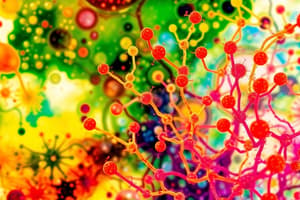Podcast
Questions and Answers
What are the three primary mechanisms by which microorganisms generate metabolic energy?
What are the three primary mechanisms by which microorganisms generate metabolic energy?
The three primary mechanisms for generating metabolic energy in microorganisms are fermentation, respiration, and photosynthesis.
List two fundamental goals of microbiological cultivation.
List two fundamental goals of microbiological cultivation.
Two fundamental goals are to raise a crop of cells of a particular species and to determine the number and type of organisms present in a given material.
Explain the significance of isolating microorganisms in pure culture.
Explain the significance of isolating microorganisms in pure culture.
Isolation in pure culture enables the study of a single species without interference from other organisms, allowing for detailed analysis of its properties and behavior.
Describe the plating method for isolating microorganisms.
Describe the plating method for isolating microorganisms.
Explain the principle behind the dilution method for isolating microorganisms.
Explain the principle behind the dilution method for isolating microorganisms.
What is the purpose of controlling factors like pH, temperature, and aeration during microbial cultivation?
What is the purpose of controlling factors like pH, temperature, and aeration during microbial cultivation?
What is meant by 'metabolically accessible form' when discussing nutrients for microorganisms?
What is meant by 'metabolically accessible form' when discussing nutrients for microorganisms?
Why is the population of microorganisms in the biosphere roughly constant?
Why is the population of microorganisms in the biosphere roughly constant?
What is the primary factor determining the survival of a microbial group within its environment?
What is the primary factor determining the survival of a microbial group within its environment?
Explain the meaning of 'growth' in the context of unicellular microorganisms.
Explain the meaning of 'growth' in the context of unicellular microorganisms.
Describe the significance of the lag phase in the bacterial growth curve.
Describe the significance of the lag phase in the bacterial growth curve.
What are the key processes occurring during the exponential phase of bacterial growth?
What are the key processes occurring during the exponential phase of bacterial growth?
How does the stationary phase differ from the exponential phase in terms of cell growth?
How does the stationary phase differ from the exponential phase in terms of cell growth?
What are the main factors contributing to the decline phase in bacterial growth?
What are the main factors contributing to the decline phase in bacterial growth?
Explain how bacteria can be maintained in the exponential phase.
Explain how bacteria can be maintained in the exponential phase.
Why are bacteria most susceptible to antibiotics during the exponential phase?
Why are bacteria most susceptible to antibiotics during the exponential phase?
Flashcards
Microbial Survival
Microbial Survival
Determined by nutrient maintenance and competition.
Growth Definition
Growth Definition
Regular increase in the sum of all components of an organism.
Unicellular Growth
Unicellular Growth
Involves cell duplication, increasing population size.
Bacterial Growth Curve
Bacterial Growth Curve
Signup and view all the flashcards
Lag Phase
Lag Phase
Signup and view all the flashcards
Exponential Phase
Exponential Phase
Signup and view all the flashcards
Stationary Phase
Stationary Phase
Signup and view all the flashcards
Decline Phase
Decline Phase
Signup and view all the flashcards
Cultivation of Microorganisms
Cultivation of Microorganisms
Signup and view all the flashcards
Nutritional Demands
Nutritional Demands
Signup and view all the flashcards
Metabolic Energy Mechanisms
Metabolic Energy Mechanisms
Signup and view all the flashcards
Cultivation Goals
Cultivation Goals
Signup and view all the flashcards
Isolation in Pure Culture
Isolation in Pure Culture
Signup and view all the flashcards
Plating Method
Plating Method
Signup and view all the flashcards
Dilution Method
Dilution Method
Signup and view all the flashcards
Survival of Microorganisms
Survival of Microorganisms
Signup and view all the flashcards
Study Notes
Cultivation of Microorganisms
- Cultivation is the process of growing organisms by providing the necessary environmental conditions.
- Organisms need energy to make complex molecules and maintain chemical balance across their membranes.
- Essential nutrients must be provided in usable forms.
- Growth factors like nutrients, pH, temperature, aeration, salt and ionic strength of the medium affect the organism’s growth.
- Organisms use fermentation, respiration or photosynthesis to generate energy.
Cultivation Methods
- To cultivate microorganisms, suitable mediums and isolating them in pure culture are necessary.
- Fundamental goals include growing cells of a specific species, determining the number and types of organisms in a sample, and isolating a specific species from a natural source.
- A single cell is isolated and cultivated to ensure progeny remain isolated.
Isolation in Pure Culture
- Plating method: Placing a small number of cells on a gelled medium like agar allows each cell to grow into an isolated colony. Agar is a polysaccharide extracted from certain red algae.
- Dilution method: Reducing the concentration of microorganisms in a sample through serial dilution and plating allows single cells to grow into pure colonies. Samples of each dilution are plated or streaked on a solid medium.
Survival of Microorganisms in the Natural Environment
- The population of microorganisms in the biosphere is relatively stable; growth is balanced by death.
- Survival depends on maintaining a viable population and access to sufficient nutrients.
- Competition and deprivation of resources strongly influence their survival.
The Meaning of Growth
- Growth is the increase in the total components of a single-celled or multicellular organism, with an increase in its size or mass over time, due to the increase in cellular components.
- In single-celled microorganisms like bacteria, growth involves cell duplication, resulting in an increased number of cells in a population.
The Growth Curve
- The growth curve describes the population dynamics of bacteria growing in a closed system.
- Distinct phases are observed: lag phase, exponential phase, stationary phase, and death phase.
- Lag phase: Cells adapt to new environment and prepare for division with minimal growth.
- Exponential phase: Rapid cell division and growth.
- Stationary phase: Cell division rate equals the death rate.
- Death phase: Nutrient depletion and accumulation of waste products lead to cell death.
The Phases of Growth
- Lag phase: Bacteria adapt to the new environment. Metabolic activity increases, but little cell division occurs. This is influenced by the organism and available nutrients and environmental conditions.
- Exponential phase: Cells divide at a constant rate, resulting in a population doubling with each generation time.
- Stationary phase: Growth slows and the population size stabilizes because the rate of new cell production equals the cell death rate.
- Death phase: Nutrient exhaustion and toxic waste accumulation cause cell death at an exponential rate. Some bacteria can survive by forming spores.
Studying That Suits You
Use AI to generate personalized quizzes and flashcards to suit your learning preferences.




